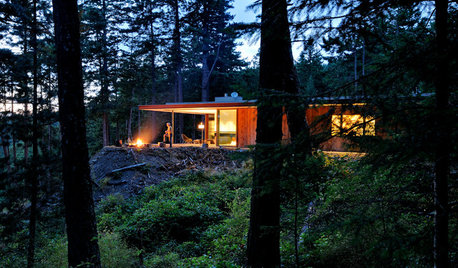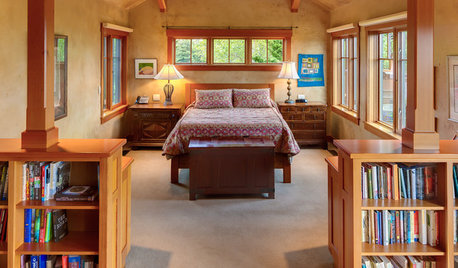Has anyone on East Coast ever tried Quercus ilex?
I got these seedlings going from a pen pal in Denmark (from acorns from a tree in Denmark) who claims they're quite hardy. They were sure eager to sprout! Half were sprouting in the package which was sent in the middle of winter.
There's a chance the Holly-leaf oak might survive our winters, but I'm not so sure about our summer heat and humidity! I'll try one in a dry location.
Does anyone know of any growing in the Mid-Atlantic region?

This post was edited by dave_in_nova on Sat, Feb 22, 14 at 17:14
Comments (54)
Huggorm
10 years agoQuercus ilex do, as far as I understand, prefer the wet summers of the UK before the dry summers of the mediterranean. The damp and hot summers of eastern USA might be too much though.
Another very hardy evergreen is the wheel tree, trochodendron aralioides. Quite unique little tree.
davidrt28 (zone 7)
10 years ago"refer the wet summers of the UK before the dry summers of the mediterranean."
In the grand scheme of things the summers in most of the UK really aren't that wet. If we compare:
ÃÂ ÃÂ July Precip.ÃÂ ÃÂ ÃÂ ÃÂ ÃÂ Jan. PrecipNYC, USAÃÂ ÃÂ 166mmÃÂ ÃÂ ÃÂ ÃÂ ÃÂ 92mm
London, UKÃÂ ÃÂ 41mmÃÂ ÃÂ ÃÂ ÃÂ ÃÂ 51mm
MonpellierÃÂ ÃÂ 16mmÃÂ ÃÂ ÃÂ ÃÂ ÃÂ 56mm
You can see that London's figures - and pattern of distribution - are closer to Montpellier's than to NYC's.
But I can certainly imagine a Q. ilex would think it had died and gone to heaven in the British Isles - usually. Generally speaking, most plants grow faster in milder climates. One reason you don't "need" as much rain is that your temps. are low enough that evapotransporation remains low and it remains comparatively lush. In fact it kinda blew my mind that when I spent a summer in Scotland, it was atypically dry for them but with the exception of the sunniest lawn areas that browned out, just a little, it stayed very lush looking, even after several weeks of no rain. (this was in eastern Scotland, of course) It's simply that when you're stuck at 65F every day, and the sun is up in the sky for a long time but not very strong, plants don't dry out quickly at all.
Related Professionals
Ashburn Landscape Architects & Landscape Designers · Garden City Landscape Architects & Landscape Designers · Pelham Landscape Contractors · Williamsburg Landscape Contractors · Lemay Landscape Contractors · Irvington Landscape Contractors · Chicago Ridge Landscape Contractors · Shenandoah Landscape Contractors · Vadnais Heights Landscape Contractors · Cave Spring Decks, Patios & Outdoor Enclosures · Detroit Decks, Patios & Outdoor Enclosures · Hendersonville Decks, Patios & Outdoor Enclosures · Medford Decks, Patios & Outdoor Enclosures · Miami Decks, Patios & Outdoor Enclosures · Santa Monica Decks, Patios & Outdoor Enclosuresdavidrt28 (zone 7)
10 years agooops, I can't really edit that msg 'cause it had escaped characters in it to try to make a chart
Should be "Montpellier", and "prefer".
It's interesting that Montpellier's January rainfall is very slightly higher than London's. Granted London is one of the drier UK cities but not the driest.Huggorm
10 years agoI did not realize just how rainy eastern US really is. We have 68mm precipitation in July where I live, I think that is much but compared to New York city that is quite dry.
alabamatreehugger 8b SW Alabama
10 years agoMuch if it comes from sudden heavy downpours. It's not the long steady drizzle that the numbers make it seem.
arktrees
10 years agoHuggorm,
In the eastern US in summer especially, averages can be very deceiving. In the southeast, the average may be 76-102 mm for July and/or August, but all or nearly of that may be in the last or first 1-3 days of a month. Some years you may have 20% of that amount for a month or even less, while other years it may be 3X that amount. The further north you go in summer, and along the gulf coast from Louisiana to Florida summer rainfall is more reliable.Arktrees
davidrt28 (zone 7)
10 years agoYes it is true that in our climate, the standard deviation of rainfall is higher than in Europe. Of course this is not just a matter of maritime versus continental; some maritime climates like California seem to be more prone to droughts; and although SE Asia is considered to be a similar climate to the SE US, drought is at least an order of magnitude less likely there because the Asian monsoon is so reliable.
Interestingly there is even surprisingly high standard deviation over short distances at least on parts of the east coast where there's just enough topographic and landform factors to influence the paths and formations of storms. Unfortunately I've forgotten how to find that NOAA data. Newark, DE, for example has more reliable summer rainfall than I do, according to the calculated SD & skew, and indeed that is what I have observed in living here since 2006.
Dave in NoVA • N. Virginia • zone 7A
Original Author10 years agoI have observed over many years living here in northern Virginia, that mid-summer droughts are quite common.
It's the hazy skies and the humidity that seems to keep things alive vs the West where humidity is very low.
Also, we can get a residual tropical storm late in the summer where we just get dumped on -- up to 10 inches at a time! But most of it runs off and that really skews our 'average' rainfall.
davidrt28 (zone 7)
10 years agoFunny coincidence.
I'm a big fan of this website, and the question of the Fahrenheit scale recently came up.
"In my 1989 column I explained that Daniel Gabriel Fahrenheit, the father of the Fahrenheit scale, based his system of temperature measurement on an earlier scale devised by Danish astronomer Ole Roemer. Roemer, I said, had set zero arbitrarily -- his main consideration was that it was colder than the temperature ever got in Denmark, because he didn't like using negative numbers in his weather logbook."Here is a link that might be useful: http://www.straightdope.com/columns/read/3146/did-cecil-err-in-explaining-the-significance-of-zero-fahrenheit
Dave in NoVA • N. Virginia • zone 7A
Original Author10 years agoYes, Denmark, from a lowest temperature perspective is likely much milder than here, but our summer heat will often help to harden off plants making them better able to endure the winter than in Denmark.
For example, I do not think they can grow Sabal minor or Crape Myrtle. Here they do OK.
Huggorm
10 years agoThat's right, sabal minor will fail in Denmark. Crape myrtle can be grown in warmer parts but will freeze back a little most winters. It will do best planted close to a south facing wall though. And it will never bloom, so it's not that exciting.
hairmetal4ever
10 years agoI think summer rainfall along much of the MD/VA I-95 corridor is somewhat influenced by a mild rain shadow from the Blue Ridge as well...moreso some years than others depending on underlying patterns. So many times my thirsty plants have seen a hopeful looking squall line fall apart fifty miles west of here
hairmetal4ever
10 years agoSo here is a random thought...
I don't think the "Ring-cupped" oaks like Q. myrsinifolia are able to cross pollinate w/Q. virginiana or fusiformis.
However, if someone could select a Q. fusiformis or even a hybrid virginiana like poaky has that is more reliably hardy to say a zone 6, with a more evergreen leaning Compton's Oak (itself already a hybrid, I realize), then maybe we'd have something. Compton's Oak is thought to be more of a zone 5 plant, and some apparently exhibit at least some tendency towards leaf retention. You could end up with something...
hairmetal4ever
10 years agoSo, from what I see, as far as hardiest to least hardy, it goes something like this for oaks:
Lithocarpus henryi-->Quercus fusiformis-->Q. myrsinifolia-->Q. acuta-->Q. ilex-->Q. virginiana
Does that appear more or less accurate?
That doesn't take into consideration Q. ilex's tolerance to heat/humidity.
Dave in NoVA • N. Virginia • zone 7A
Original Author10 years agoHairmetal, I'd put a Q. virginiana before Q. acuta, especially one of northern provenance. No experience with Q. ilex yet.
davidrt28 (zone 7)
10 years agoyes the hardier Q. virginiana in Williamsburg (i.e., all of the ones planted there) were barely or lightly affected by 0F in 1994 (as was the Q. myrsinifolia that was in the parking lot of the Williamsburg Inn), while the Quercus acuta had very visible damage. The top didn't die but it was defoliated and had some branch die back.
Hopefully someone will post what the Q. acutas at the National Arboretum look like. That would be interesting. It didn't get to 0F as Wmbg did in 1994, but the cold was sustained over a longer period. If there was a major lesson learnt this year it concerned duration versus intensity. I'm convinced if we'd only had the first round with 3F, I'd have much, much less damage to my plants.
This post was edited by davidrt28 on Thu, Mar 13, 14 at 14:51
Dave in NoVA • N. Virginia • zone 7A
Original Author10 years agodavid you are so right.
I don't think we set any records with our coldest temp, but the DURATION, oh my goodness! Not only numerous nights in low single digits, but numerous spans of time under 32 degrees for HIGHS!
Plus winds. I have never seen the lorapetalums and 'hardy citrus' so damaged as I have this year. Tracy palms are crispy too. Too early to tell if any of those are even alive above ground.
hairmetal4ever
10 years agoNo all-time records that I can think of were broken this winter in the East, although a few March monthly records were early this month.
I also think that cold blast earlier this month may have done more damage than the previous ones, we had just enough mild days that some more tender plants that, at that point, were still alive, started dehardening and waking up a bit, only to be blasted with 0 degrees yet again.
poaky1
9 years agoBy now some may know that my Q. Virginiana "late drop" died to the ground this past winter. It has come back from the bottom of the trunk and has shot up to the same height as before last winter {{gwi:331469}} I know it had been fine the previous winter. This past winter from hell did it in. I kept checking it, the last couple weeks did it in, it was fine before then. The leaves were gone, well it looked fine before those last 2 weeks, but I kept seeing good buds well into May, wishful thinking I guess. But if you are in zone 6b or 7, you should be fine. I want to add that the Turner's oak (Q. Robur X Q. Ilex) is hard to get (illegal to send to the US) in the US. I had gotten one thanks to a nice Brit, who found a way to send me one. They are usually grafted, I was told that they rarely self seed. Mine croaked, so is also zone 7 hardy. The Compton's are a surely hardy relative of the Q. Virginiana for me. I am letting my Q. Virginiana grow again, but I am not going to expect much. I have 4 Compton's coming to me soon. As mentioned they vary in leaf persistence. The one closest to our house is shaped nice with wide spreading limbs, (it's small yet, though) but has shed it's foliage sooner than a couple over the hill. Look on the Colonial Williamsburg, Wv website, there is a picture of a mature Compton's oak. Well, even Yahoo images. The tree shown, is impressive, but the leaves don't stay on that Compton's, and the climate is at the least zone 7. I had tried a pure Q. Ilex and zone 6 is too cold, and I had tried it during a normal winter here. I hope I helped.
georgeinbandonoregon
9 years agoFWIW, some thoughts on evergreen oaks---probably all species without a proven track record in your area will benefit from at least initial "kid glove" treatment---planting in a cold wind protected sunny spot, good to excellent drainage (especially for the Mediterranean types), and likely some winter protection (mulching around the base and/or at least a temporary shelter for the whole plant on at least the coldest nights---even the potentially hardiest species likely are not fully hardy until well established in marginal areas. FWIW, along with the llex I might suggest trying chrysolepis and hypoleucoides (apparently surviving at the Denver botanic gardens) and turbinella. both hypoleucoides and turbinella are from climates with at least some summer rain and thus may be better adapted to the south east's climates. hope this is of some interest.
davidrt28 (zone 7)
9 years agoThe problem is a marginally hardy evergreen oak is not a very satisfactory garden plant. In the winters it doesn't retain leaves, it looks very bad. Most people could live with that being 1 in 10 to even 1 in 5 winters, but not 1 in 3 or 1 in 2. The people who bought my parent's former house cut down the Quercus suber I planted as a teen after a cold winter. I suspect the top would have resprouted, but I'm sure it looked awful. They aren't even very pretty when they are in leaf...until they got 20+ years old IMHO. Ugly, wiry branch structure.
Oddly though, the seedling Turner's oak I got from Woodlanders years ago now no longer even tries to retain its leaves. The harsher North American winters vs. NW Europe seems to have triggered some epigenetic change. It just drops them in November even before it freezes but...alas...without even a little color change! Interestingly, it was agonizingly slow in the earlier years when it tried to stay evergreen, now it is merely very slow. But at any rate without the evergreen-ness, you're left with a boring looking, slow growing, oak that doesn't color in fall. Yawn.
Given the tragic appearance of the Hill's nursery west branch on Rt. 7 in Great Falls (was just back in the 703 this summer), I can only imagine the Arlington location is teetering on complete oblivion too. They could have at least sold one location to preserve the other. Which means all the plants there will be destroyed for redevelopment soon if they haven't already been. But, you could (have seen)/see there some northern live oaks vs. a real Q. X turneri graft from Belgium that Mr. Hill imported in the 1950s. The Q. virginianas were much bigger...the Q. X turneri almost looked like a dwarf. (granted it was 10 years ago I was visiting...but it was still 45 years old!) My point in all this is if a 1/2 Q. ilex grows so slowly and poorly in our climate, I don't think there's much hope for Q. ilex itself. It is used to the (usually) cloudy, rainy, mild winters of western Europe. Even hardier Q. virginiana are probably overall better adapted to the mid-Atlantic climate; and certainly the hardier Asian evergreen oaks as well.
davidrt28 (zone 7)
9 years ago"but our summer heat will often help to harden off plants making them better able to endure the winter than in Denmark."
Except this mostly doesn't apply to plants from western Europe because summers aren't very hot there anyhow. Only to plants from Asia and North America.
PS - as to the Hill's Arlington location...not very promising! Written in 2008!:
Here is a link that might be useful: http://www.yelp.com/biz/hills-nursery-and-camellia-gardens-arlington
This post was edited by davidrt28 on Sat, Sep 6, 14 at 7:23
Huggorm
9 years agoSpain is in western Europe and they have quite hot summers there. Just watch the old movie "The good, the bad and the ugly" with Clint Easywood to find out.
davidrt28 (zone 7)
9 years agoI knew someone would say that.
But the native range of Q. ilex includes some areas like southern France/NE Spain that are not really hot by US standards - I can't find any stations but this is especially true because it is often found at elevations around 500-1000 meters, where the nights in particular are cooler than right along the Mediterranean. Barcelona as I've pointed out, is only about as hot as Boston in the summer...even Marseille, considered a very hot city by French standards, is cooler than Philadelphia in summer.In any case it has grow in southern England since the 16th century, has survived the cold winters since then and is in fact considered "invasive" there...so clearly doesn't need hot summers. (coldest in the past 200 years in London, to the best of my ability to research their arcane way of keeping records, was only 9F/-13C)
I might accept this argument more for Pinus pinea, whose true native range according to Herr Resin _is_ restricted to the hotter southern Iberian; and not surprisingly it has demonstrated a likely ability to harden better in heat. He said it's known to have been injured in the worst winters in SE England, but JC Raulston recorded the plant at the NCSU Arboretum as having no injury from -9F/-22C! Sadly that one got the chop for the new visitor's center. My own P. pinea was clearly hardier than Q. ilex or Q. suber in our climate.
salicaceae
9 years agoThere are a few nice Q. ilex scattered in the deep south..Savannah, GA..even one in Atlanta. I have one in Gainesville, FL..but its still quite small and not overly happy.
poaky1
9 years agoI wish I could grow one here. I guess it is a finicky tree. It must be able to take heat if it grows in Spain and Italy. You may think, okay it hates humidity. But Britain is humid, right? I don't know if Spain is humid as well as hot. The Savannah, Ga Ilex's are in heat and humidity. Is Florida more humid than Atlanta and Savannah? Well, Salicaceae, maybe yours will get settled and grow better. Maybe it is a soil issue. In the Uk and Europe, the soil may be moister than in Florida. There is likely more "organic matter" in the soils where the tree is native. Meaning more moisture retention. I am kinda grasping at straws for a sensible explanation. I think that this one is likely close to the correct explanation actually. It is a big time WAG, though.
georgeinbandonoregon
9 years agosome climatic and environmental considerations FWIW--- the soil may be moist in the british isles but it is likely cooler than soils on the east coast of north america in the summer (cooler air temps as well). the species grows well in the summer dry pacific northwest (USDA 7-9) either with some summer irrigation in the warmer interior areas or with no summer water at all in the cooler coastal areas once established(as long as the soil is reasonably deep) but both interior and coastal areas here have generally cool nights, anyway. the tree does quite well in the central valley of california with very hot summers with relatively low amounts of summer water once established but humidity is quite low. likewise, most of the mediterranean regions are relatively summer dry and often of low humidity compared to your region as you probably already know the species likely has at least two challenges---low temps in the winter that may damage the tree and likely high heat and humidity in the summer and it may be that the effects are synergistic---the plant that suffers in the cold winter may suffer more when it has to deal with the heat and humidity of summer while trying to recover from the winter??? good drainage (slope or mound planting) may help deal with some of the humidity caused disease problems, planting in a sunny but protected from cold winter problems MAY help with some of the summer disease problems (good air circulation) and help somewhat with the winter problems,too finally, there is always the chance that even with hardy selections/good provenances of this species, it may not be reliably hardy in your area as a normal unprotected garden plant. if you do not already have healthy mature broadleaf evergreen trees of various species in your area or have only a very few and those need favorable micro-climates you may (sadly) be SOL for this and many other species.(hopefully not). good luck.
gardenprincethenetherlandsZ7/8
9 years agoThis tree can be found in the interior of Spain where it can get very hot in the summer (40+C/104+F). Also very little rain in the summer (only the occasional thunderstorm) and low humidity. So this tree can cope with high temperatures. The combination high humidity with high temperatures might be problematic for this oak.
In the Netherlands this tree gained in popularity in the period 1997-2009. In that period we had hardly any winters at all and more plants from the Mediterranean region began to appear in Dutch gardens and sometimes were even advertised as hardy. But when the winters returned these plant suffered. Especially in the harsh winter of 2011-12 with temperatures to -20C/-4F many of those plants died or showed considerable damage. As consequence plants like Quercus ilex fell out of favor.
Dave in NoVA • N. Virginia • zone 7A
Original Author9 years agoThanks all. I have many other evergreen oak selections that are likely better candidates for my region. But I always like to try new things. I'll just stick them back in the bed somewhere where if they die out, no big deal.
Q. virginiana, Q. myrsinifolia, and Q. phillyraeoides did pretty well after our last winter. Q. virginiana did best of all with no die back or even defoliation.
davidrt28 (zone 7)
9 years agoWow, this has proven to be a popular thread. Additional posters (thanks, Willows) have just corroborated what I'd said much earlier: it wouldn't have problems with typical southern heat & humidity, but it probably should not even be called zn 7 hardy. More like zn 8.
(I excluded New Orleans as a kind of "but not the absolute worst places in the south" limiter, but the excellent growth of Date palms there illustrates the paradox of certain dry climate Mediterranean plants in such a wet, humid one. As I said before, the Med. is both more humid now than certain other "Med. climate" places like California or Chile, and was once probably much more humid. There are old olive trees in Charleston; there are certainly no old Lyonothamnus trees there!)davidrt28 (zone 7)
9 years agoGardenPrince - I believe Quercus X turneri is also popular in the Low Countries. I would suppose they survived the cold winter but lost their leaves. In a normal (zn 8, but more freezes than England) winter there, do they keep their leaves?
davidrt28 (zone 7)
9 years agoDave, you must have a good clone of Q. virginiana if it wasn't injured in the recent winter. The one at University of Delaware looked pretty rough. Did you get it from the central US or East Coast hardier ecotypes? The Williamsburg trees were barely damaged by 1994, but it only went to 0F there and it was only one major cold spell that winter. (though a more serious one than the 3-4 we had last winter) It was at most -4F in DC and environs - more like -9F in my garden, and I suspect that would have damaged any evergreen oak except maybe Lithocarpus henryi.
poaky1
9 years agoHairmetal, I THINK, told me to try Lithocarpus Henryi. I may be wrong on WHO told me though, I am trying to remember, though. I did some research online and saw it was zone 7 hardy. So, davidrt28, are you possibly saying that it is hardier than zone 7? The Lithocarpus henryi? If it is really PROVEN to be, I will try and shoehorn it in somewhere. At present, I am moving shrubs out of my yard to make room for a couple "special" oaks. If I am wrong on the Lithocarpus Henryi, sorry hairmetal. I DO have to add that the Live oak "late drop" from Mossy oak natives nursery is the hardiest Live oak to the best of my knowledge. It took many -0F days to die. It was fine after winter 2012-2013. The last beoch of a winter did kill it back to the lower trunk. It regenerated in June 2014, enough to grow to 31/2 ft tall by late June. I believe that IF this next winter has fewer below 0F days/nights, mine the (Quercus Virginiana) will be fine. I am not gonna hold my breath, but i really do think that Q. Virginiana "late drop", is MUCH hardier than Lithocarpus Henryi. Prove me wrong and I will plant the hardier lithocvarpus Henryi.
poaky1
9 years agoI just realised that my last post had nothing to do with the original post. But there are several zone 7 evergreen oaks. So the OP has many to choose from anyway, so whatever, I guess.
Dave in NoVA • N. Virginia • zone 7A
Original Author9 years agoDavidrt28:
I actually have three Q. virginianas in my yard. They are all over 14 feet tall, and unfortunately I do not recall absolutely where they come from BUT they are all acorn-grown (by me) from long-term trees growing either in the Tidewater VA or in the DC area.
I do recall having collected lots of acorns from the William and Mary campus. Whether those 'W&M' trees are of local provinence or were grown from more southern stock, I would have no idea. BUT since Q. virginiana is native to the Tidewater (lower down), it may very well be that many of those old trees are local (and therefore hardier) in origin than one grown in say Florida.
But I was very pleased with their tolerance of this last winter. It looks like they have a few acorns of their own, if you are interested.
This post was edited by dave_in_nova on Wed, Sep 24, 14 at 9:22
hairmetal4ever
9 years agoL. henryi is said to be about the hardiest evergreen "oak". I've seen other boards where people in zone 6 have had them survive for decades and several negative teens temps.
Davidrt28 has recommended it, but I might have said it based on his recommendation. I have yet to be able to find one, however.
Woodlanders doesn't carry it anymore, and they told me they weren't sure if they would be again.
davidrt28 (zone 7)
9 years agoCistus has them (L. henryi) this year, I think.
Though it would certainly be prudent to ask about their seed source.
Mine was fully hardy this winter, not even a touch of leaf discoloration or injury. Major issue with it has been it is one of the only BLEs in my garden completely delectable to the local hoofed rats...thank goodness it's in the minority, knock on wood. Unlike the northeastern super-strain of deer, mine don't eat poisonous Ericaceae. But they've munched it down to the ground, twice, so it's development has been majorly slowed down. Now I have a very sturdy fence around it and it is slowly recovering.
Interestingly as far as I can tell, with the trees in Howard Co. MD (that survived -16F) they don't eat the foliage but they do devour the acorns the minute they ripen in the fall, stymieing my efforts to get them w/o using a ladder. Something else like a crow or jay eats the high ones!hairmetal4ever
9 years agoDavid - I believe on another forum, someone in Kansas (Wichita area, zone 6) has an L. henryi that is over 20 yrs old.
davidrt28 (zone 7)
9 years agoWow, well that is pretty darn impressive.
Kansas is a whole 'nother kind of stressor on plants. Good information to know.
BTW Dave - 3 14' Quercus virginiana in Northern Virginia is pretty impressive too. But they are all post 1994, right? There was a great article in the Post (how I found out about the Hills and their oaks) about the history of live oaks in the DC area, and how Lady Bird Johnson wanted to plant one but the White House gardeners told her it would not be hardy enough. Not sure if she got her way but some of the oldest in the DC area were known to be on the campus of St. Elizabeth's...I wonder if they will be preserved.This post was edited by davidrt28 on Wed, Sep 24, 14 at 18:24
Dave in NoVA • N. Virginia • zone 7A
Original Author9 years agoDavid,
Are there really live oaks (Q. virginiana) on campus of St. E's? One of the oldest I know of is near Glebe and Columbia Pike.
No, mine have only been in the ground since 2007 (the oldest one). They do grow fast, but snow loads are an issue.
I have several Lith. henryi seedlings (Protect from rabbits too!!) in pots and one planted in ground. Are they fairly easy to transplant? Do they do OK in FULL sun without getting leaf burn in winter?

davidrt28 (zone 7)
9 years agoThat isn't far from the original Hill's nursery. I wonder if he planted it.
Yes, yes L. henryi is just like any other plant...not some fussy camellia or something. Green light to planting in full sun.St. E's was being redeveloped so those trees could well have been removed by now. They are discussed in the Choukas-Bradley 'City of Trees' book which I'd go find for you except it's somehow gotten separated from the rest of my gardening books.
Dave in NoVA • N. Virginia • zone 7A
Original Author9 years agoIf my big Red Bay doesn't handle another winter, I'm putting in a Lithocarpus then. Thanks.
poaky1
9 years agoAfter hearing this Whichita zone 6 20 year old L Henryi stuff, I am intrigued. I would imagine Cistus is a Maryland area local nursery? I will be looking for a mail order source, damn tree addiction .....
Dave in NoVA • N. Virginia • zone 7A
Original Author9 years agoThey are in Oregon. Good company.
Here is a link that might be useful: Cistus Nursery page
Dave in NoVA • N. Virginia • zone 7A
Original Author9 years agoI just wanted to post that I was out at the National Arboretum a few weeks ago.
The large Q. acutas looked like they sustained some damage from teh past winter. Some twig and a few branches died back. Sad to see. But they will certainly survive.
The Q. salicina looked like it had NO damage at all surprisingly. I have never seen acorns on them.
Interestingly the Q. phillyreoides had some acorns. No apparent dieback. They all looked rather shrubby to me and not large single trunked trees.
L. henyri and Q. myrsinifolias looked just fine.
Q. glauca specimens at the Arboretum have all had a rough go of it over the years. Numerous diebacks. Pretty pathetic. They should really not be grown up here. But maybe they got some northern provenance stock that they wanted to try. I didn't see where they were from.
Unrelated, but all the hollies looked great. Even Ilex latifolia. The Ilex latifolia in my yard looks great as well. No apparent winter damage. A small amount of leaf spot but overall I was very pleased.
This post was edited by dave_in_nova on Fri, Oct 17, 14 at 10:33
davidrt28 (zone 7)
9 years agoDave,
Hate to keep bumping this but thanks for the post. I kept meaning to get to the National Arboretum this year but never got around to it. I almost went ot the Kelaidis lecture but didn't. Anyhow also thanks for corroborating what I'd written elsewhere. Q. acuta and Q. glauca are just not fully hardy in zn 7 so scratch them from the hardy evergreen oak list. It's good to know there was no damage to the Q.phillyreoides.
I. latifolia and I. vomitoria at the Udel arboretum had a bit of leaf burning but nothing too serious. My Koehne hollies, OTOH, were 100% unaffected. (and my Highclere holly, 'James G Esson')Dave in NoVA • N. Virginia • zone 7A
Original Author9 years agoYou mention Koehne hollies ... probably some of the most underused hollies of all time for large gorgeous evergeen trees. I have at least three cultivars -- Agena, Lassie, and a no-ID Koehne from a local nursery. Then I have a latifolia x cornuta hybrid with large quilted leaves that looks more like a Koehne than anything. Really spectacular trees.
Move over Nellie Stevens.

















charlotte1866